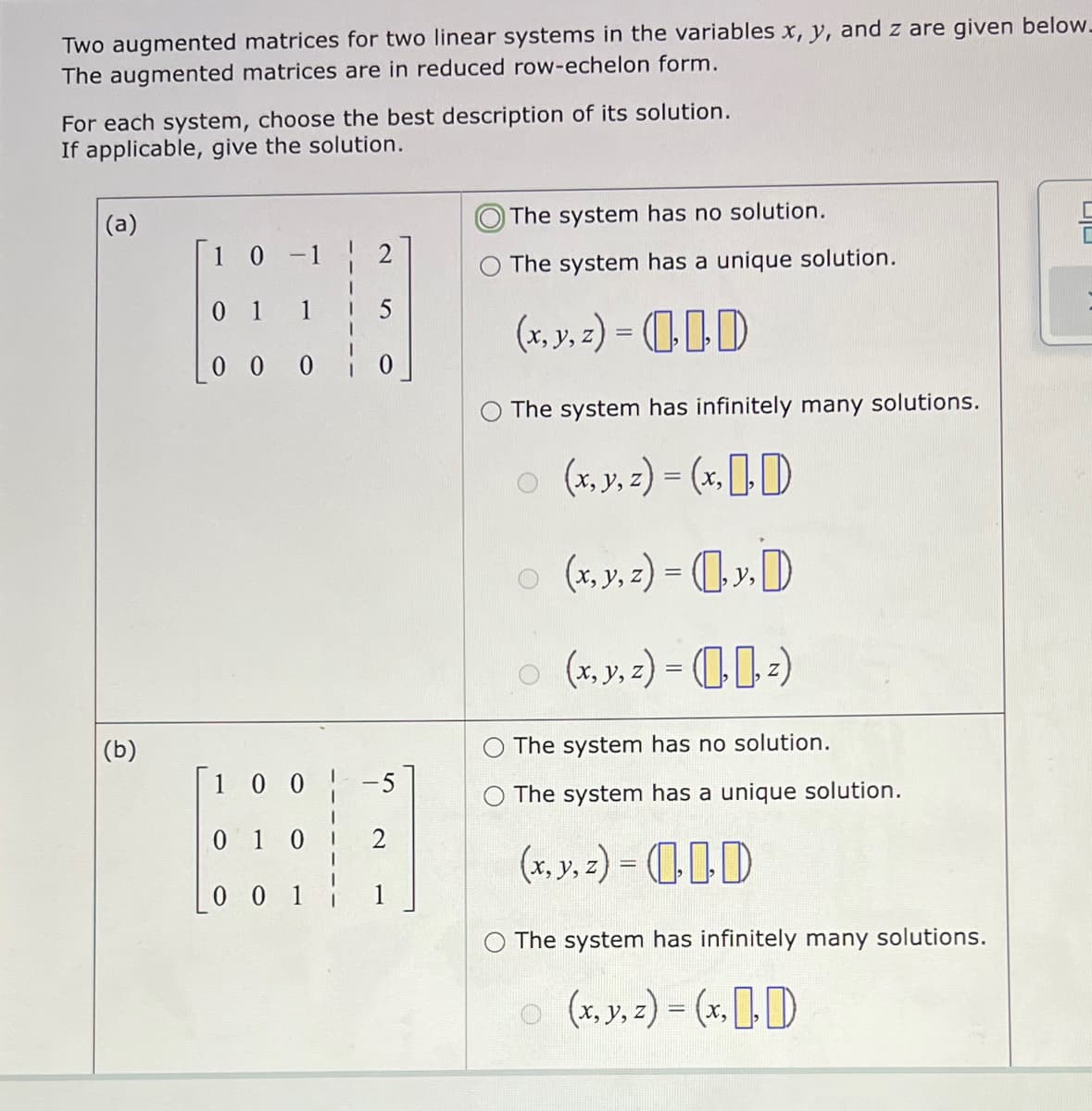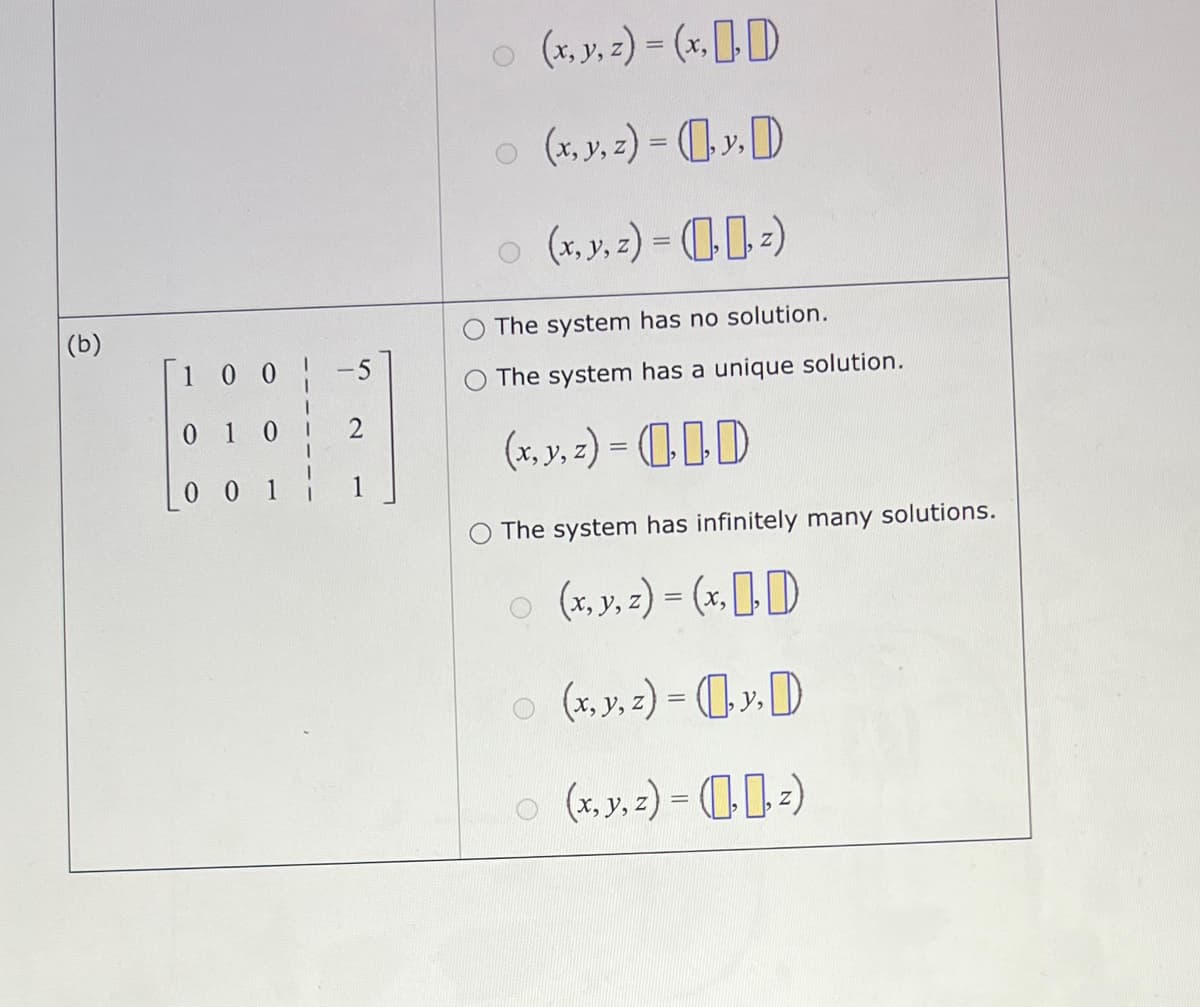(a) The system has no solution. [1 0 -1 2 The system has a unique solution. 0 1 1 (x, y, 2) = (1LD 0 0 0 The system has infinitely many solutions. o (x,y, 2) = (x,LD (,y, 2) = 1-) (b) The system has no solution. |1 0 0 -5 The system has a unique solution. 0 1 0 (x, y, z) = (1L) 0 0 1i 1 The system has infinitely many solutions. o (x, y, 2) = (x, LD
(a) The system has no solution. [1 0 -1 2 The system has a unique solution. 0 1 1 (x, y, 2) = (1LD 0 0 0 The system has infinitely many solutions. o (x,y, 2) = (x,LD (,y, 2) = 1-) (b) The system has no solution. |1 0 0 -5 The system has a unique solution. 0 1 0 (x, y, z) = (1L) 0 0 1i 1 The system has infinitely many solutions. o (x, y, 2) = (x, LD
College Algebra
7th Edition
ISBN:9781305115545
Author:James Stewart, Lothar Redlin, Saleem Watson
Publisher:James Stewart, Lothar Redlin, Saleem Watson
Chapter6: Matrices And Determinants
Section: Chapter Questions
Problem 4CC
Related questions
Question

Transcribed Image Text:Two augmented matrices for two linear systems in the variables x, y, and z are given below.
The augmented matrices are in reduced row-echelon form.
For each system, choose the best description of its solution.
If applicable, give the solution.
(a)
The system has no solution.
1 0
-1
The system has a unique solution.
0 1
1 5
(x, y, 2) = 1ID
0 0 0
The system has infinitely many solutions.
(x, y, 2) = (x, [1,)
o (x, y, 2) = (y. )
(x, y, 2) = (1-)
(b)
The system has no solution.
1 0 0
The system has a unique solution.
0 1 0
(x, y, z) = (111)
0 0 1
The system has infinitely many solutions.
o (x, y. 2) = (x., LD

Transcribed Image Text:o (1, y, 2) = (x, [11)
%3D
o (x, y, =) = 1-)
(b)
The system has no solution.
[1 0 0
-5
The system has a unique solution.
0 1 0
(x, y. 2) = 11D
0 0 1 1
The system has infinitely many solutions.
o (r, y. 2) = (x.L)
o (x,y. 2) = y. )
o (4, y, =) = 1-)
Expert Solution
This question has been solved!
Explore an expertly crafted, step-by-step solution for a thorough understanding of key concepts.
Step by step
Solved in 3 steps

Recommended textbooks for you

College Algebra
Algebra
ISBN:
9781305115545
Author:
James Stewart, Lothar Redlin, Saleem Watson
Publisher:
Cengage Learning

Algebra and Trigonometry (MindTap Course List)
Algebra
ISBN:
9781305071742
Author:
James Stewart, Lothar Redlin, Saleem Watson
Publisher:
Cengage Learning

Algebra for College Students
Algebra
ISBN:
9781285195780
Author:
Jerome E. Kaufmann, Karen L. Schwitters
Publisher:
Cengage Learning

College Algebra
Algebra
ISBN:
9781305115545
Author:
James Stewart, Lothar Redlin, Saleem Watson
Publisher:
Cengage Learning

Algebra and Trigonometry (MindTap Course List)
Algebra
ISBN:
9781305071742
Author:
James Stewart, Lothar Redlin, Saleem Watson
Publisher:
Cengage Learning

Algebra for College Students
Algebra
ISBN:
9781285195780
Author:
Jerome E. Kaufmann, Karen L. Schwitters
Publisher:
Cengage Learning

College Algebra (MindTap Course List)
Algebra
ISBN:
9781305652231
Author:
R. David Gustafson, Jeff Hughes
Publisher:
Cengage Learning

Elementary Linear Algebra (MindTap Course List)
Algebra
ISBN:
9781305658004
Author:
Ron Larson
Publisher:
Cengage Learning
